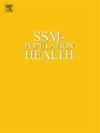美国公立学校极端高温天气的社会差异
IF 3.1
2区 医学
Q1 PUBLIC, ENVIRONMENTAL & OCCUPATIONAL HEALTH
引用次数: 0
摘要
虽然儿童很容易受到高温的影响,而且大部分时间都呆在学校,但在以前关于热暴露分布和影响的社会不平等的研究中,学校地点的极端高温事件并没有得到充分的检验。我们通过对美国公立学校极端炎热天气的社会人口差异进行首次全国性研究来解决这一差距。使用绝对温度(>90°F)和相对温度(>;结果表明,与白人和非符合条件的学生相比,种族/少数民族学生和有资格享受免费/减少午餐的学生在极端高温天气频率最高的学校(全国前20%)中的比例明显过高。根据绝对温度阈值。根据相对温度阈值,在排名前20%的学校中也观察到类似的种族/民族差异,黑人和亚洲学生除外。控制空间聚类和背景因素的多变量模型也揭示了种族/民族差异,无论使用何种温度阈值,在为西班牙裔和美洲印第安学生服务的学校,极端高温天的频率明显更高。这些结果突出表明,迫切需要将学龄儿童纳入未来关于热暴露社会差异的研究中,在其他地区、州和国家进行更详细的调查,并制定干预措施和政策,提供公平的极端高温保护。本文章由计算机程序翻译,如有差异,请以英文原文为准。
Social disparities in extreme heat days across U.S. public schools
Although children are highly vulnerable to higher temperatures and spend significant portions of their time at school, extreme heat events at school locations have not been adequately examined in previous research on social inequalities in the distribution and impacts of heat exposure. We address this gap by conducting the first nationwide study of sociodemographic disparities in extremely hot days at U.S. public schools. Annual frequency of extreme heat days at school locations is measured using both absolute (>90 °F) and relative (> local 95th percentile) temperature-based thresholds, and linked to race/ethnicity, socioeconomic status, and other relevant characteristics of students and schools in the conterminous U.S. Results indicate that racial/ethnic minority students and those eligible for free/reduced lunch are significantly overrepresented in schools with the highest frequency of extreme heat days (top 20 % nationally) compared to White and non-eligible students, respectively, based on the absolute temperature threshold. Similar racial/ethnic disparities are observed in the top 20 % of schools based on the relative temperature threshold, with the exception of Black and Asian students. Multivariable models that control for spatial clustering and contextual factors also reveal racial/ethnic disparities, with significantly higher frequencies of extreme heat days at schools serving Hispanic and American Indian students, regardless of the temperature threshold utilized. These results highlight the urgent need to include school children in future research on social disparities in heat exposure, conduct more detailed investigations in other regions, states, and nations, and formulate interventions and policies that provide equitable protection from extreme heat.
求助全文
通过发布文献求助,成功后即可免费获取论文全文。
去求助
来源期刊

Ssm-Population Health
PUBLIC, ENVIRONMENTAL & OCCUPATIONAL HEALTH-
CiteScore
6.50
自引率
2.10%
发文量
298
审稿时长
101 days
期刊介绍:
SSM - Population Health. The new online only, open access, peer reviewed journal in all areas relating Social Science research to population health. SSM - Population Health shares the same Editors-in Chief and general approach to manuscripts as its sister journal, Social Science & Medicine. The journal takes a broad approach to the field especially welcoming interdisciplinary papers from across the Social Sciences and allied areas. SSM - Population Health offers an alternative outlet for work which might not be considered, or is classed as ''out of scope'' elsewhere, and prioritizes fast peer review and publication to the benefit of authors and readers. The journal welcomes all types of paper from traditional primary research articles, replication studies, short communications, methodological studies, instrument validation, opinion pieces, literature reviews, etc. SSM - Population Health also offers the opportunity to publish special issues or sections to reflect current interest and research in topical or developing areas. The journal fully supports authors wanting to present their research in an innovative fashion though the use of multimedia formats.
 求助内容:
求助内容: 应助结果提醒方式:
应助结果提醒方式:


